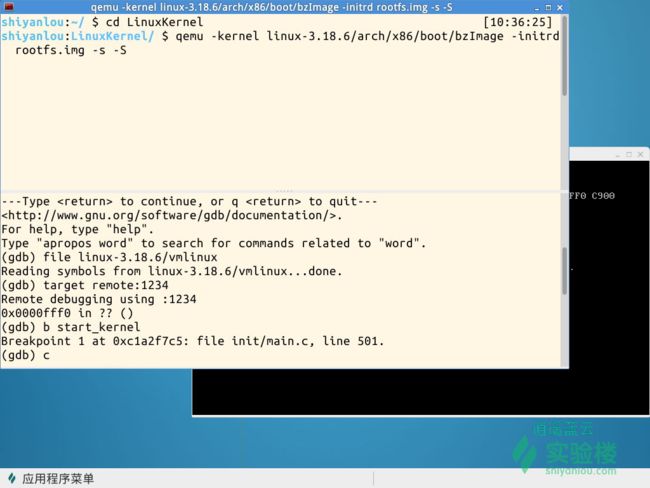代码分析
asmlinkage __visible void __init start_kernel(void)
{
char*command_line;
char *after_dashes;
/*
* Need to run as early as possible, to initialize the
* lockdep hash:
*/
lockdep_init();/*初始化内核依赖的关系表*/
set_task_stack_end_magic(&init_task);
smp_setup_processor_id();/*指定当前的cpu的逻辑号,这个函数对应于对称多处理器的设置,当系统中只有一个cpu的情况,此函数为空,什么也不做*/
debug_objects_early_init(); /*
* Set up the the initial canary ASAP:
*/
boot_init_stack_canary();
cgroup_init_early();
local_irq_disable();/*关闭当前CUP中断*/
early_boot_irqs_disabled = true;/*
* Interrupts are still disabled. Do necessary setups, then
* enable them
*/
boot_cpu_init();/*对于多CPU核的系统来说,设置第一个CPU核为活跃 CPU核。对于单CPU核系统来说,设置CPU核为活跃 CPU核*/
page_address_init();/*页表结构初始化*/
pr_notice("%s", linux_banner);/*输出Linux版本信息*/
setup_arch(&command_line);/*设置与体系结构相关的环境*/
mm_init_cpumask(&init_mm);
setup_command_line(command_line);/*保存未改变的comand_line到字符数组static_command_line[] 中。保存 boot_command_line到字符数组saved_command_line[]中*/
setup_nr_cpu_ids();
setup_per_cpu_areas();/*每个CPU分配pre-cpu结构内存, 并复制.data.percpu段的数据*/
smp_prepare_boot_cpu(); /* arch-specific boot-cpu hooks */
build_all_zonelists(NULL, NULL);
page_alloc_init();
pr_notice("Kernel command line: %s\n", boot_command_line);
parse_early_param();
after_dashes = parse_args("Booting kernel",
static_command_line, __start___param,
__stop___param - __start___param,
-1, -1, &unknown_bootoption); if (!IS_ERR_OR_NULL(after_dashes))
parse_args("Setting init args", after_dashes, NULL, 0, -1, -1,
set_init_arg);
jump_label_init(); /*
* These use large bootmem allocations and must precede
* kmem_cache_init()
*/
setup_log_buf(0);
pidhash_init();
vfs_caches_init_early();
sort_main_extable();
trap_init();/* * trap_init函数完成对系统保留中断向量(异常、非屏蔽中断以及系统调用)* 的初始化*/
mm_init(); /*
* Set up the scheduler prior starting any interrupts (such as the
* timer interrupt). Full topology setup happens at smp_init()
* time - but meanwhile we still have a functioning scheduler.
*/
sched_init();/*核心进程调度器初始化,调度器的初始化的优先级要高于任何中断的建立,并且初始化进程0,即idle进程,但是并没有设置idle进程的NEED_RESCHED标志,所以还会继续完成内核初始化剩下的事情。*/
/*
* Disable preemption - early bootup scheduling is extremely
* fragile until we cpu_idle() for the first time.
*/
preempt_disable();/*进制内核的抢占。使当前进程的 struct thread_info结构 preempt_count成员的值增加1。*/
if (WARN(!irqs_disabled(), "Interrupts were enabled *very* early, fixing it\n"))
local_irq_disable();/*关闭当前CUP中断*/
idr_init_cache();
rcu_init();
context_tracking_init();
radix_tree_init(); /* init some links before init_ISA_irqs() */
early_irq_init();
init_IRQ();/*初始化IRQ中断和终端描述符。*/
tick_init();
rcu_init_nohz();
init_timers();
hrtimers_init(); /* 对高精度时钟进行初始化 */
softirq_init();/*初始化软中断。*/
timekeeping_init();/*初始化资源和普通计时器*/
time_init();/*时间、定时器初始化*/
sched_clock_postinit();
perf_event_init();
profile_init();/*对内核的一个性能测试工具profile进行初始化*/
call_function_init();
WARN(!irqs_disabled(), "Interrupts were enabled early\n");
early_boot_irqs_disabled = false;
local_irq_enable();
kmem_cache_init_late(); /*
* HACK ALERT! This is early. We're enabling the console before
* we've done PCI setups etc, and console_init() must be aware of
* this. But we do want output early, in case something goes wrong.
*/
console_init();/*控制台初始化*/
if (panic_later)
panic("Too many boot %s vars at `%s'", panic_later,
panic_param);
lockdep_info();/*打印锁依赖信息*/
/*
* Need to run this when irqs are enabled, because it wants
* to self-test [hard/soft]-irqs on/off lock inversion bugs
* too:
*/
locking_selftest();#ifdef CONFIG_BLK_DEV_INITRD
if (initrd_start && !initrd_below_start_ok &&
page_to_pfn(virt_to_page((void *)initrd_start)) < min_low_pfn) {
pr_crit("initrd overwritten (0x%08lx < 0x%08lx) - disabling it.\n",
page_to_pfn(virt_to_page((void *)initrd_start)),
min_low_pfn);
initrd_start = 0;
}#endif
page_cgroup_init();
debug_objects_mem_init();
kmemleak_init();
setup_per_cpu_pageset();
numa_policy_init(); if (late_time_init)
late_time_init();
sched_clock_init();
calibrate_delay();
pidmap_init();
anon_vma_init();
acpi_early_init();#ifdef CONFIG_X86
if (efi_enabled(EFI_RUNTIME_SERVICES))
efi_enter_virtual_mode();#endif#ifdef CONFIG_X86_ESPFIX64
/* Should be run before the first non-init thread is created */
init_espfix_bsp();#endif
thread_info_cache_init();
cred_init();
fork_init(totalram_pages); /* 根据物理内存大小计算允许创建进程的数量 */
proc_caches_init();
buffer_init();
key_init();
security_init();
dbg_late_init();
vfs_caches_init(totalram_pages);
signals_init(); /* rootfs populating might need page-writeback */
page_writeback_init();
proc_root_init();
cgroup_init();
cpuset_init();
taskstats_init_early();
delayacct_init();
check_bugs(); /*
* 测试该CPU的各种缺陷,记录检测到的缺陷,以便于内核的其他部分以后可以
* 使用它们的工作。
*/
sfi_init_late(); if (efi_enabled(EFI_RUNTIME_SERVICES)) {
efi_late_init();
efi_free_boot_services();
}
ftrace_init(); /* Do the rest non-__init'ed, we're now alive */
rest_init();/*从rest_init开始,Linux开始产生进程*/}实验总结
从老师的视频,网上查找的资料。再通过做实验,已经对linux内核从开始初始化到init进程的建立有一个初步的概念,说道idle进程就不得不提到init_task.init_task进程在Linux中属于一个比较特殊的进程,它是内核开发者人为制造出来的,而不是其他进程通过do_fork来完成。init_task对象的初始化在内核代码来完成.Linux在无进程概念的情况下将一直从初始化部分的代码执行到start_kernel,然后再到其最后一个函数调用rest_init。从rest_init开始,Linux开始产生进程,因为init_task是静态制造出来的,pid=0,在rest_init函数中,内核将通过下面的代码产生第一个真正的进程(pid=1):
kernel_thread(kernel_init, NULL, CLONE_FS);而此时init_task的任务基本上已经完全结束了,它将成为为一个idle task,事实上sched_init()函数中,通过init_idle(current, smp_processor_id())函数的调用就已经把init_task初始化成了一个idle task,init_idle函数的第一个参数current就是&init_task,在init_idle中将会把init_task加入到cpu的运行队列中,这样当运行队列中没有别的就绪进程时,init_task(也就是idle task)将会被调用.



